Knowledge Sharing: Social Media's Role in Multinational Corporations
VerifiedAdded on 2023/06/11
|8
|2605
|189
Essay
AI Summary
This essay explores the impact of social media on knowledge management within multinational corporations (MNCs). It discusses how social media platforms facilitate knowledge sharing, build social capital, support innovation, and aid in problem-solving. The essay highlights the importance of differentiating between internal and external knowledge bases for effective communication and knowledge dissemination. It also examines how social media enables MNCs to promote products and services, improve internal knowledge sharing among employees, and foster innovation through crowdsourcing and consumer feedback. Furthermore, the essay addresses the risks associated with social media use, such as data breaches, decreased productivity, and negative publicity. It concludes that while social media offers significant advantages for MNCs in today's competitive environment, careful management and policy implementation are essential to mitigate potential risks and maximize the benefits of collaboration, innovation, and knowledge sharing. Desklib provides access to this and many other solved assignments.
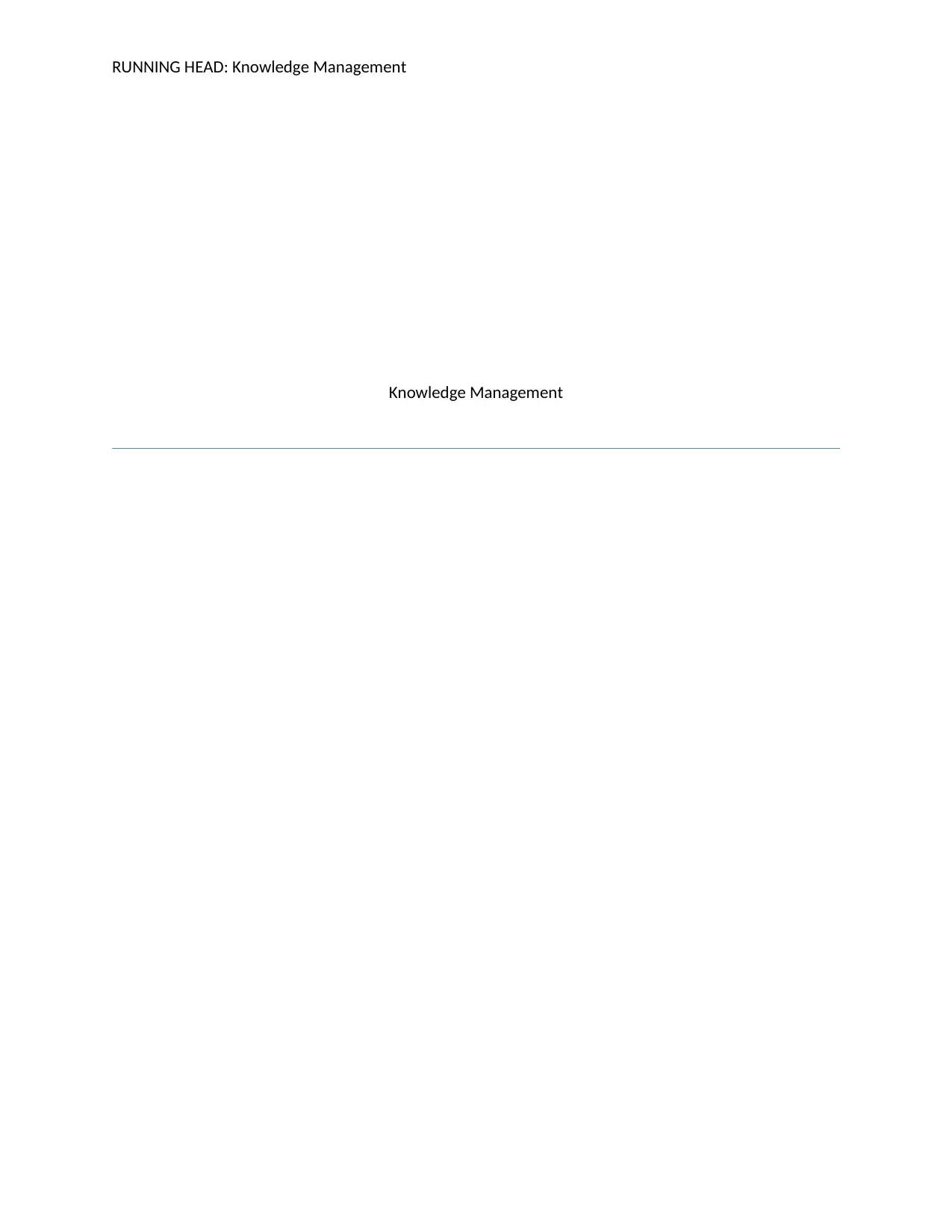
RUNNING HEAD: Knowledge Management
Knowledge Management
Knowledge Management
Paraphrase This Document
Need a fresh take? Get an instant paraphrase of this document with our AI Paraphraser
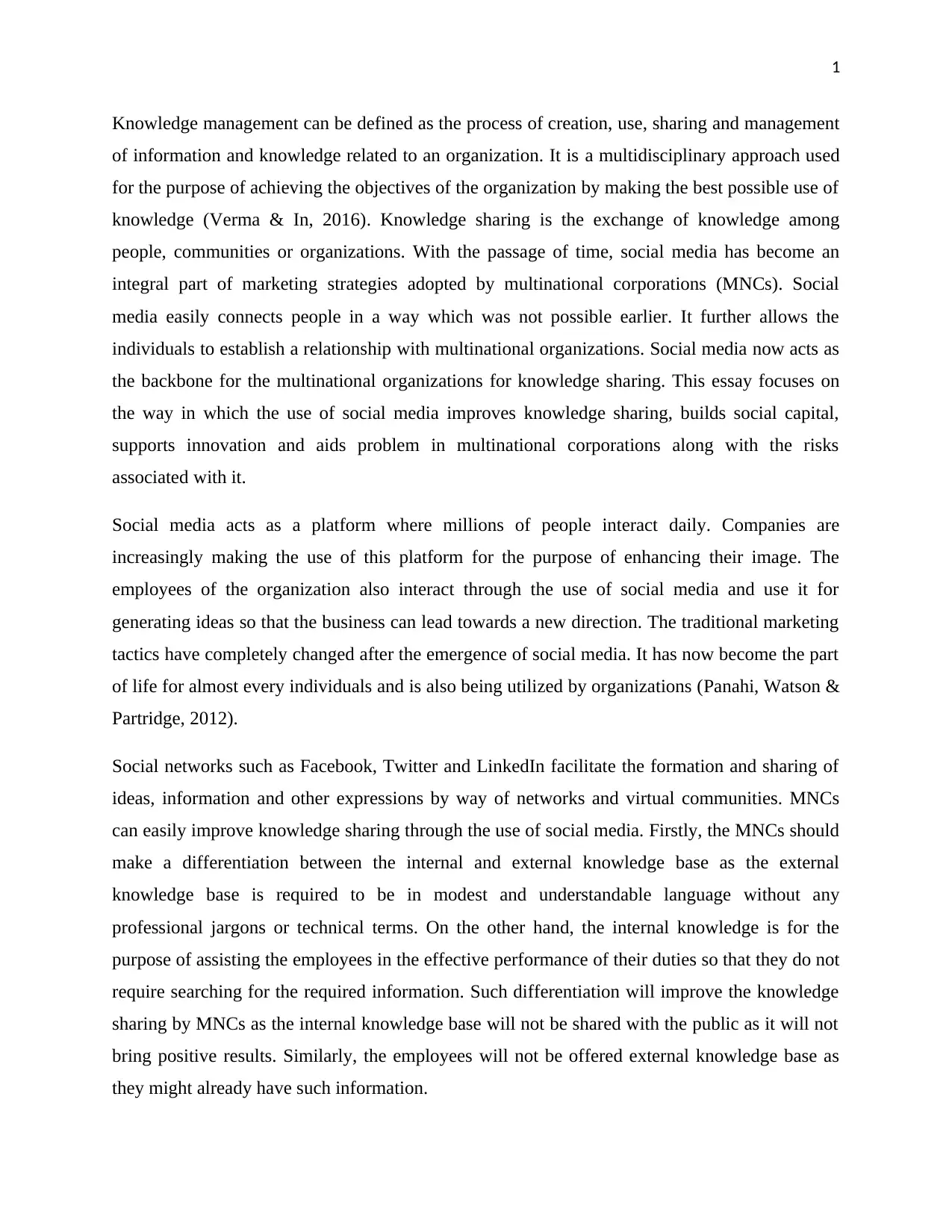
1
Knowledge management can be defined as the process of creation, use, sharing and management
of information and knowledge related to an organization. It is a multidisciplinary approach used
for the purpose of achieving the objectives of the organization by making the best possible use of
knowledge (Verma & In, 2016). Knowledge sharing is the exchange of knowledge among
people, communities or organizations. With the passage of time, social media has become an
integral part of marketing strategies adopted by multinational corporations (MNCs). Social
media easily connects people in a way which was not possible earlier. It further allows the
individuals to establish a relationship with multinational organizations. Social media now acts as
the backbone for the multinational organizations for knowledge sharing. This essay focuses on
the way in which the use of social media improves knowledge sharing, builds social capital,
supports innovation and aids problem in multinational corporations along with the risks
associated with it.
Social media acts as a platform where millions of people interact daily. Companies are
increasingly making the use of this platform for the purpose of enhancing their image. The
employees of the organization also interact through the use of social media and use it for
generating ideas so that the business can lead towards a new direction. The traditional marketing
tactics have completely changed after the emergence of social media. It has now become the part
of life for almost every individuals and is also being utilized by organizations (Panahi, Watson &
Partridge, 2012).
Social networks such as Facebook, Twitter and LinkedIn facilitate the formation and sharing of
ideas, information and other expressions by way of networks and virtual communities. MNCs
can easily improve knowledge sharing through the use of social media. Firstly, the MNCs should
make a differentiation between the internal and external knowledge base as the external
knowledge base is required to be in modest and understandable language without any
professional jargons or technical terms. On the other hand, the internal knowledge is for the
purpose of assisting the employees in the effective performance of their duties so that they do not
require searching for the required information. Such differentiation will improve the knowledge
sharing by MNCs as the internal knowledge base will not be shared with the public as it will not
bring positive results. Similarly, the employees will not be offered external knowledge base as
they might already have such information.
Knowledge management can be defined as the process of creation, use, sharing and management
of information and knowledge related to an organization. It is a multidisciplinary approach used
for the purpose of achieving the objectives of the organization by making the best possible use of
knowledge (Verma & In, 2016). Knowledge sharing is the exchange of knowledge among
people, communities or organizations. With the passage of time, social media has become an
integral part of marketing strategies adopted by multinational corporations (MNCs). Social
media easily connects people in a way which was not possible earlier. It further allows the
individuals to establish a relationship with multinational organizations. Social media now acts as
the backbone for the multinational organizations for knowledge sharing. This essay focuses on
the way in which the use of social media improves knowledge sharing, builds social capital,
supports innovation and aids problem in multinational corporations along with the risks
associated with it.
Social media acts as a platform where millions of people interact daily. Companies are
increasingly making the use of this platform for the purpose of enhancing their image. The
employees of the organization also interact through the use of social media and use it for
generating ideas so that the business can lead towards a new direction. The traditional marketing
tactics have completely changed after the emergence of social media. It has now become the part
of life for almost every individuals and is also being utilized by organizations (Panahi, Watson &
Partridge, 2012).
Social networks such as Facebook, Twitter and LinkedIn facilitate the formation and sharing of
ideas, information and other expressions by way of networks and virtual communities. MNCs
can easily improve knowledge sharing through the use of social media. Firstly, the MNCs should
make a differentiation between the internal and external knowledge base as the external
knowledge base is required to be in modest and understandable language without any
professional jargons or technical terms. On the other hand, the internal knowledge is for the
purpose of assisting the employees in the effective performance of their duties so that they do not
require searching for the required information. Such differentiation will improve the knowledge
sharing by MNCs as the internal knowledge base will not be shared with the public as it will not
bring positive results. Similarly, the employees will not be offered external knowledge base as
they might already have such information.
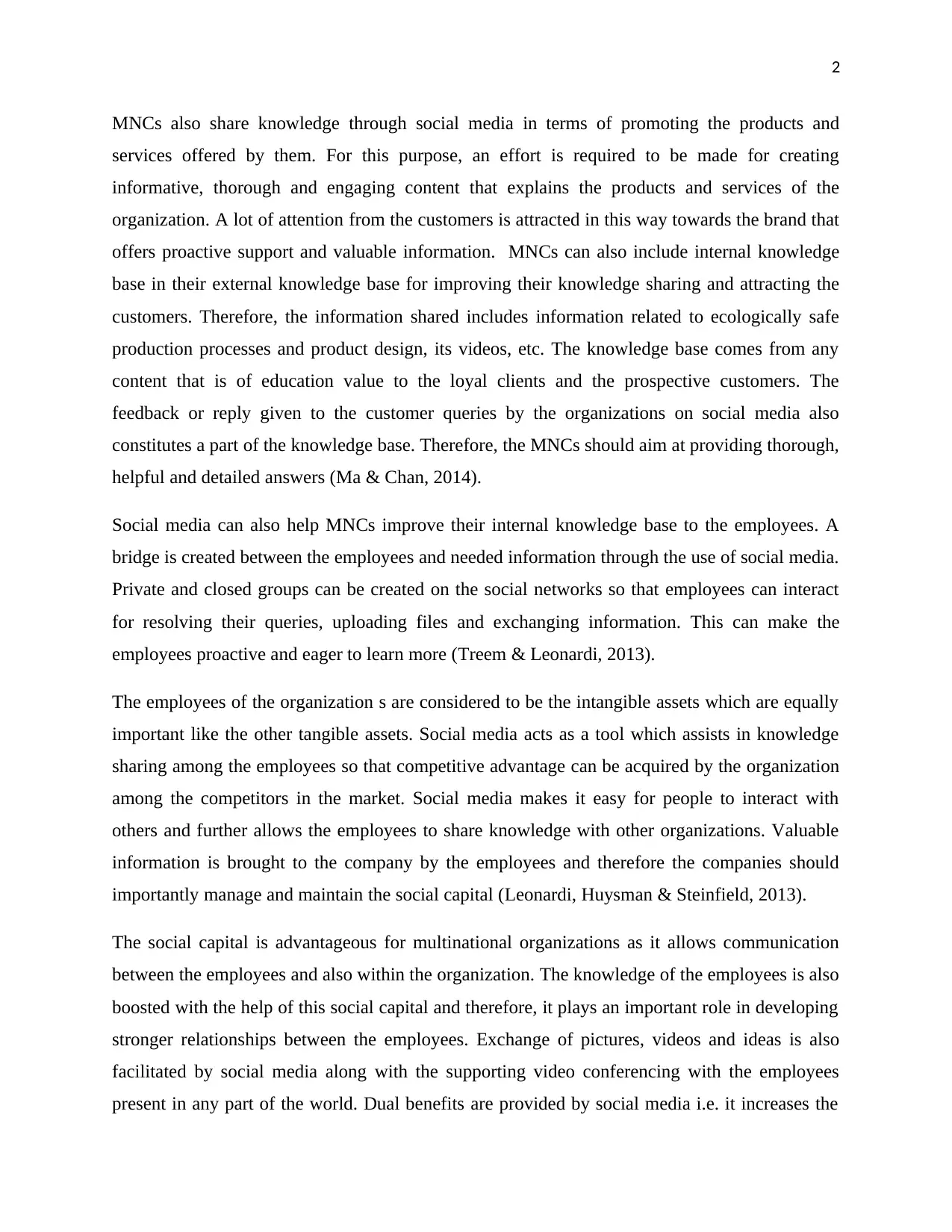
2
MNCs also share knowledge through social media in terms of promoting the products and
services offered by them. For this purpose, an effort is required to be made for creating
informative, thorough and engaging content that explains the products and services of the
organization. A lot of attention from the customers is attracted in this way towards the brand that
offers proactive support and valuable information. MNCs can also include internal knowledge
base in their external knowledge base for improving their knowledge sharing and attracting the
customers. Therefore, the information shared includes information related to ecologically safe
production processes and product design, its videos, etc. The knowledge base comes from any
content that is of education value to the loyal clients and the prospective customers. The
feedback or reply given to the customer queries by the organizations on social media also
constitutes a part of the knowledge base. Therefore, the MNCs should aim at providing thorough,
helpful and detailed answers (Ma & Chan, 2014).
Social media can also help MNCs improve their internal knowledge base to the employees. A
bridge is created between the employees and needed information through the use of social media.
Private and closed groups can be created on the social networks so that employees can interact
for resolving their queries, uploading files and exchanging information. This can make the
employees proactive and eager to learn more (Treem & Leonardi, 2013).
The employees of the organization s are considered to be the intangible assets which are equally
important like the other tangible assets. Social media acts as a tool which assists in knowledge
sharing among the employees so that competitive advantage can be acquired by the organization
among the competitors in the market. Social media makes it easy for people to interact with
others and further allows the employees to share knowledge with other organizations. Valuable
information is brought to the company by the employees and therefore the companies should
importantly manage and maintain the social capital (Leonardi, Huysman & Steinfield, 2013).
The social capital is advantageous for multinational organizations as it allows communication
between the employees and also within the organization. The knowledge of the employees is also
boosted with the help of this social capital and therefore, it plays an important role in developing
stronger relationships between the employees. Exchange of pictures, videos and ideas is also
facilitated by social media along with the supporting video conferencing with the employees
present in any part of the world. Dual benefits are provided by social media i.e. it increases the
MNCs also share knowledge through social media in terms of promoting the products and
services offered by them. For this purpose, an effort is required to be made for creating
informative, thorough and engaging content that explains the products and services of the
organization. A lot of attention from the customers is attracted in this way towards the brand that
offers proactive support and valuable information. MNCs can also include internal knowledge
base in their external knowledge base for improving their knowledge sharing and attracting the
customers. Therefore, the information shared includes information related to ecologically safe
production processes and product design, its videos, etc. The knowledge base comes from any
content that is of education value to the loyal clients and the prospective customers. The
feedback or reply given to the customer queries by the organizations on social media also
constitutes a part of the knowledge base. Therefore, the MNCs should aim at providing thorough,
helpful and detailed answers (Ma & Chan, 2014).
Social media can also help MNCs improve their internal knowledge base to the employees. A
bridge is created between the employees and needed information through the use of social media.
Private and closed groups can be created on the social networks so that employees can interact
for resolving their queries, uploading files and exchanging information. This can make the
employees proactive and eager to learn more (Treem & Leonardi, 2013).
The employees of the organization s are considered to be the intangible assets which are equally
important like the other tangible assets. Social media acts as a tool which assists in knowledge
sharing among the employees so that competitive advantage can be acquired by the organization
among the competitors in the market. Social media makes it easy for people to interact with
others and further allows the employees to share knowledge with other organizations. Valuable
information is brought to the company by the employees and therefore the companies should
importantly manage and maintain the social capital (Leonardi, Huysman & Steinfield, 2013).
The social capital is advantageous for multinational organizations as it allows communication
between the employees and also within the organization. The knowledge of the employees is also
boosted with the help of this social capital and therefore, it plays an important role in developing
stronger relationships between the employees. Exchange of pictures, videos and ideas is also
facilitated by social media along with the supporting video conferencing with the employees
present in any part of the world. Dual benefits are provided by social media i.e. it increases the
⊘ This is a preview!⊘
Do you want full access?
Subscribe today to unlock all pages.

Trusted by 1+ million students worldwide
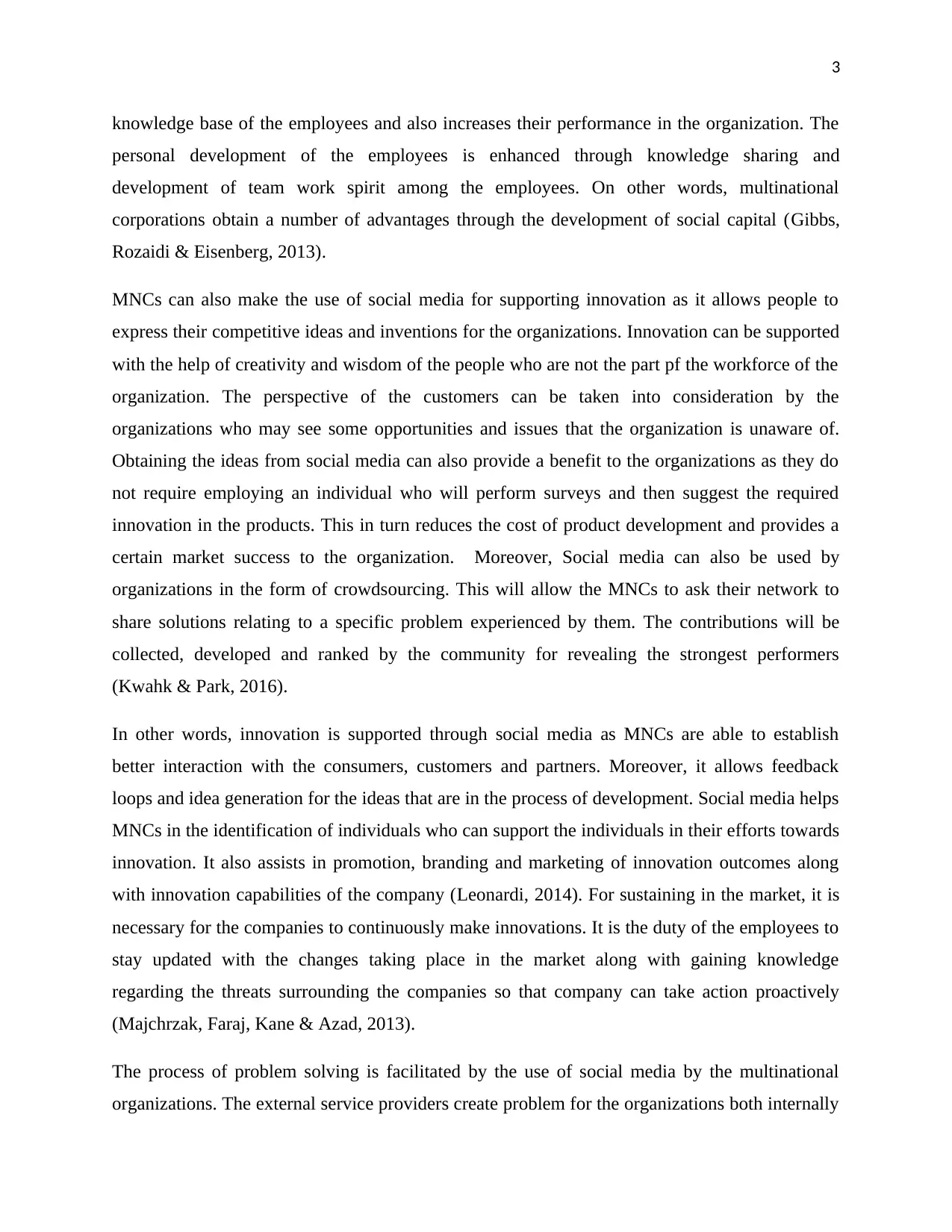
3
knowledge base of the employees and also increases their performance in the organization. The
personal development of the employees is enhanced through knowledge sharing and
development of team work spirit among the employees. On other words, multinational
corporations obtain a number of advantages through the development of social capital (Gibbs,
Rozaidi & Eisenberg, 2013).
MNCs can also make the use of social media for supporting innovation as it allows people to
express their competitive ideas and inventions for the organizations. Innovation can be supported
with the help of creativity and wisdom of the people who are not the part pf the workforce of the
organization. The perspective of the customers can be taken into consideration by the
organizations who may see some opportunities and issues that the organization is unaware of.
Obtaining the ideas from social media can also provide a benefit to the organizations as they do
not require employing an individual who will perform surveys and then suggest the required
innovation in the products. This in turn reduces the cost of product development and provides a
certain market success to the organization. Moreover, Social media can also be used by
organizations in the form of crowdsourcing. This will allow the MNCs to ask their network to
share solutions relating to a specific problem experienced by them. The contributions will be
collected, developed and ranked by the community for revealing the strongest performers
(Kwahk & Park, 2016).
In other words, innovation is supported through social media as MNCs are able to establish
better interaction with the consumers, customers and partners. Moreover, it allows feedback
loops and idea generation for the ideas that are in the process of development. Social media helps
MNCs in the identification of individuals who can support the individuals in their efforts towards
innovation. It also assists in promotion, branding and marketing of innovation outcomes along
with innovation capabilities of the company (Leonardi, 2014). For sustaining in the market, it is
necessary for the companies to continuously make innovations. It is the duty of the employees to
stay updated with the changes taking place in the market along with gaining knowledge
regarding the threats surrounding the companies so that company can take action proactively
(Majchrzak, Faraj, Kane & Azad, 2013).
The process of problem solving is facilitated by the use of social media by the multinational
organizations. The external service providers create problem for the organizations both internally
knowledge base of the employees and also increases their performance in the organization. The
personal development of the employees is enhanced through knowledge sharing and
development of team work spirit among the employees. On other words, multinational
corporations obtain a number of advantages through the development of social capital (Gibbs,
Rozaidi & Eisenberg, 2013).
MNCs can also make the use of social media for supporting innovation as it allows people to
express their competitive ideas and inventions for the organizations. Innovation can be supported
with the help of creativity and wisdom of the people who are not the part pf the workforce of the
organization. The perspective of the customers can be taken into consideration by the
organizations who may see some opportunities and issues that the organization is unaware of.
Obtaining the ideas from social media can also provide a benefit to the organizations as they do
not require employing an individual who will perform surveys and then suggest the required
innovation in the products. This in turn reduces the cost of product development and provides a
certain market success to the organization. Moreover, Social media can also be used by
organizations in the form of crowdsourcing. This will allow the MNCs to ask their network to
share solutions relating to a specific problem experienced by them. The contributions will be
collected, developed and ranked by the community for revealing the strongest performers
(Kwahk & Park, 2016).
In other words, innovation is supported through social media as MNCs are able to establish
better interaction with the consumers, customers and partners. Moreover, it allows feedback
loops and idea generation for the ideas that are in the process of development. Social media helps
MNCs in the identification of individuals who can support the individuals in their efforts towards
innovation. It also assists in promotion, branding and marketing of innovation outcomes along
with innovation capabilities of the company (Leonardi, 2014). For sustaining in the market, it is
necessary for the companies to continuously make innovations. It is the duty of the employees to
stay updated with the changes taking place in the market along with gaining knowledge
regarding the threats surrounding the companies so that company can take action proactively
(Majchrzak, Faraj, Kane & Azad, 2013).
The process of problem solving is facilitated by the use of social media by the multinational
organizations. The external service providers create problem for the organizations both internally
Paraphrase This Document
Need a fresh take? Get an instant paraphrase of this document with our AI Paraphraser
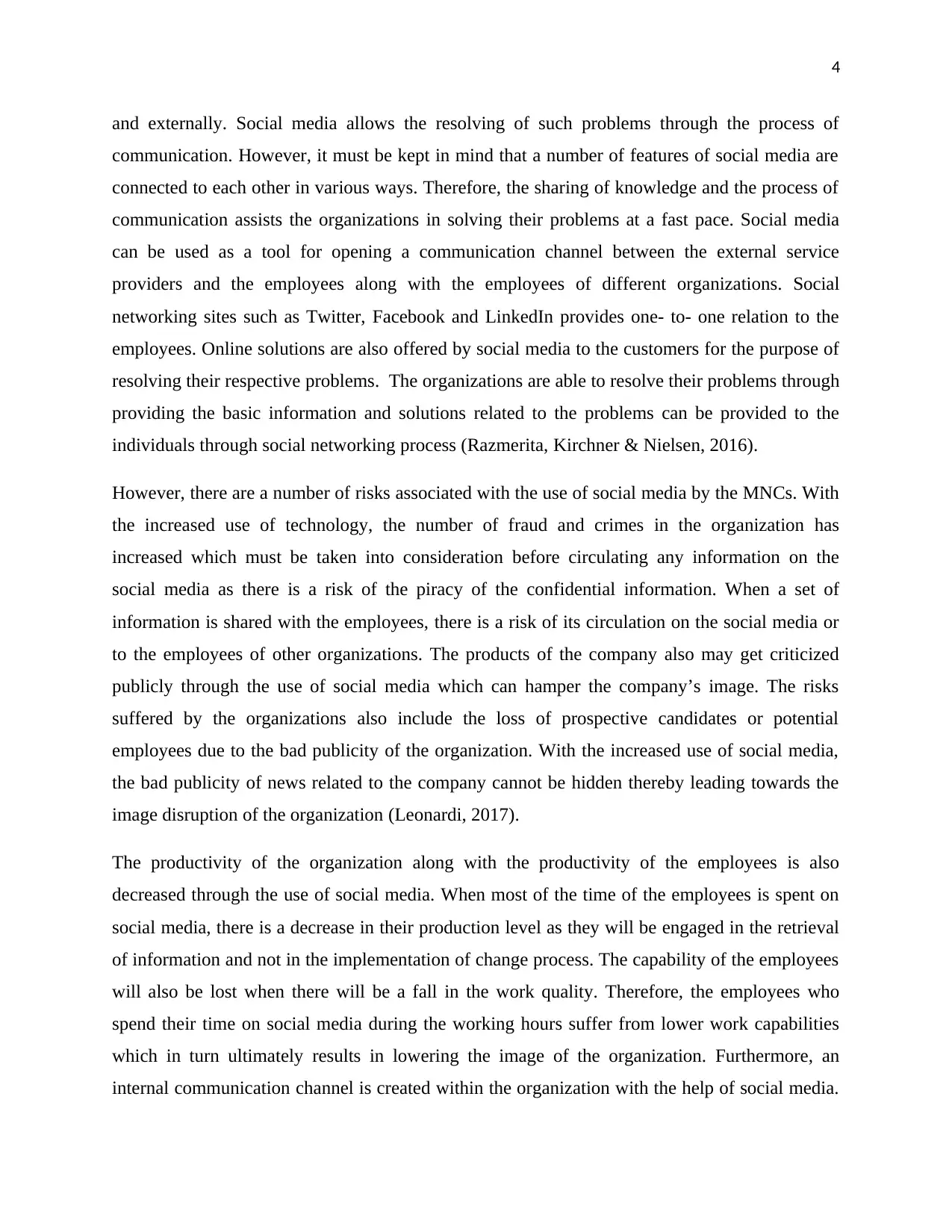
4
and externally. Social media allows the resolving of such problems through the process of
communication. However, it must be kept in mind that a number of features of social media are
connected to each other in various ways. Therefore, the sharing of knowledge and the process of
communication assists the organizations in solving their problems at a fast pace. Social media
can be used as a tool for opening a communication channel between the external service
providers and the employees along with the employees of different organizations. Social
networking sites such as Twitter, Facebook and LinkedIn provides one- to- one relation to the
employees. Online solutions are also offered by social media to the customers for the purpose of
resolving their respective problems. The organizations are able to resolve their problems through
providing the basic information and solutions related to the problems can be provided to the
individuals through social networking process (Razmerita, Kirchner & Nielsen, 2016).
However, there are a number of risks associated with the use of social media by the MNCs. With
the increased use of technology, the number of fraud and crimes in the organization has
increased which must be taken into consideration before circulating any information on the
social media as there is a risk of the piracy of the confidential information. When a set of
information is shared with the employees, there is a risk of its circulation on the social media or
to the employees of other organizations. The products of the company also may get criticized
publicly through the use of social media which can hamper the company’s image. The risks
suffered by the organizations also include the loss of prospective candidates or potential
employees due to the bad publicity of the organization. With the increased use of social media,
the bad publicity of news related to the company cannot be hidden thereby leading towards the
image disruption of the organization (Leonardi, 2017).
The productivity of the organization along with the productivity of the employees is also
decreased through the use of social media. When most of the time of the employees is spent on
social media, there is a decrease in their production level as they will be engaged in the retrieval
of information and not in the implementation of change process. The capability of the employees
will also be lost when there will be a fall in the work quality. Therefore, the employees who
spend their time on social media during the working hours suffer from lower work capabilities
which in turn ultimately results in lowering the image of the organization. Furthermore, an
internal communication channel is created within the organization with the help of social media.
and externally. Social media allows the resolving of such problems through the process of
communication. However, it must be kept in mind that a number of features of social media are
connected to each other in various ways. Therefore, the sharing of knowledge and the process of
communication assists the organizations in solving their problems at a fast pace. Social media
can be used as a tool for opening a communication channel between the external service
providers and the employees along with the employees of different organizations. Social
networking sites such as Twitter, Facebook and LinkedIn provides one- to- one relation to the
employees. Online solutions are also offered by social media to the customers for the purpose of
resolving their respective problems. The organizations are able to resolve their problems through
providing the basic information and solutions related to the problems can be provided to the
individuals through social networking process (Razmerita, Kirchner & Nielsen, 2016).
However, there are a number of risks associated with the use of social media by the MNCs. With
the increased use of technology, the number of fraud and crimes in the organization has
increased which must be taken into consideration before circulating any information on the
social media as there is a risk of the piracy of the confidential information. When a set of
information is shared with the employees, there is a risk of its circulation on the social media or
to the employees of other organizations. The products of the company also may get criticized
publicly through the use of social media which can hamper the company’s image. The risks
suffered by the organizations also include the loss of prospective candidates or potential
employees due to the bad publicity of the organization. With the increased use of social media,
the bad publicity of news related to the company cannot be hidden thereby leading towards the
image disruption of the organization (Leonardi, 2017).
The productivity of the organization along with the productivity of the employees is also
decreased through the use of social media. When most of the time of the employees is spent on
social media, there is a decrease in their production level as they will be engaged in the retrieval
of information and not in the implementation of change process. The capability of the employees
will also be lost when there will be a fall in the work quality. Therefore, the employees who
spend their time on social media during the working hours suffer from lower work capabilities
which in turn ultimately results in lowering the image of the organization. Furthermore, an
internal communication channel is created within the organization with the help of social media.
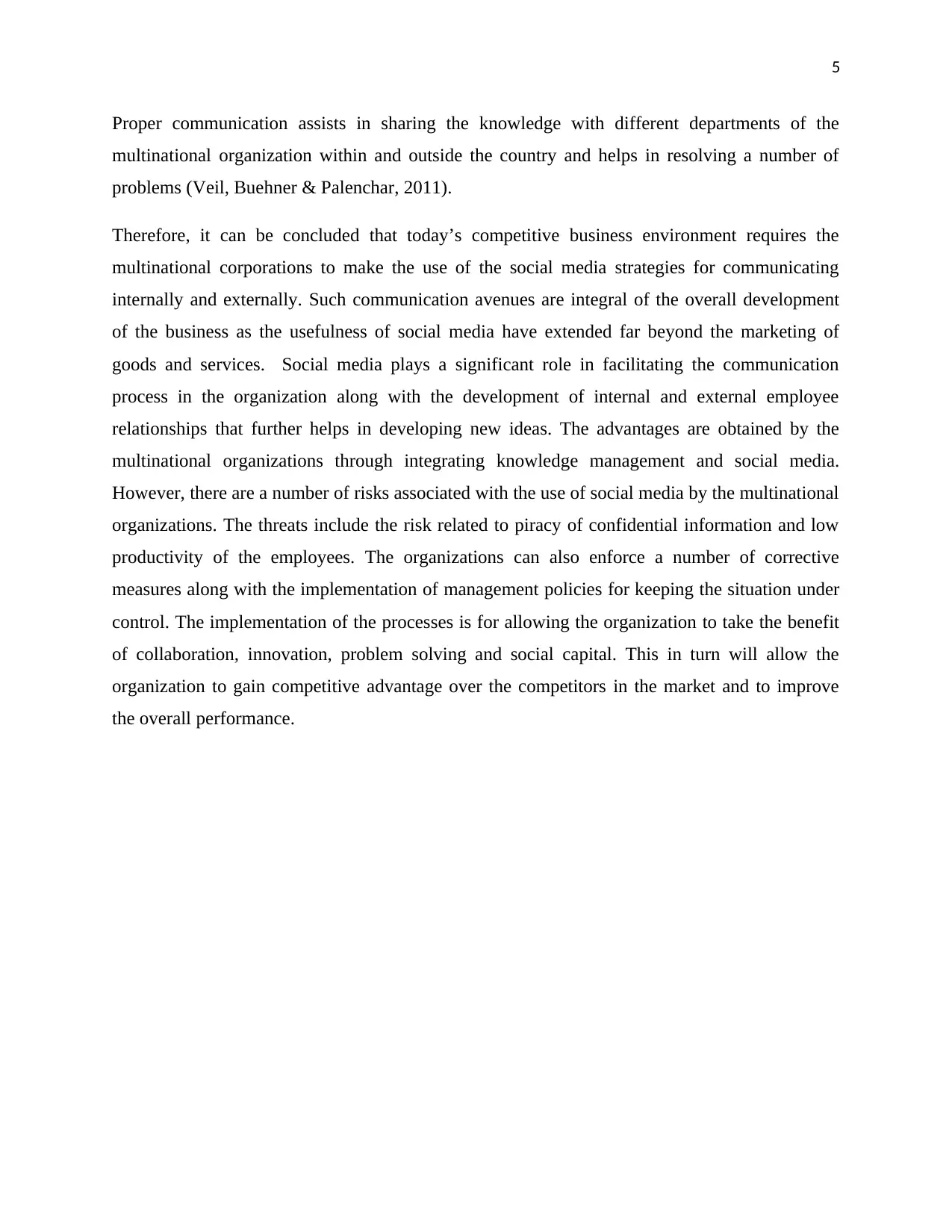
5
Proper communication assists in sharing the knowledge with different departments of the
multinational organization within and outside the country and helps in resolving a number of
problems (Veil, Buehner & Palenchar, 2011).
Therefore, it can be concluded that today’s competitive business environment requires the
multinational corporations to make the use of the social media strategies for communicating
internally and externally. Such communication avenues are integral of the overall development
of the business as the usefulness of social media have extended far beyond the marketing of
goods and services. Social media plays a significant role in facilitating the communication
process in the organization along with the development of internal and external employee
relationships that further helps in developing new ideas. The advantages are obtained by the
multinational organizations through integrating knowledge management and social media.
However, there are a number of risks associated with the use of social media by the multinational
organizations. The threats include the risk related to piracy of confidential information and low
productivity of the employees. The organizations can also enforce a number of corrective
measures along with the implementation of management policies for keeping the situation under
control. The implementation of the processes is for allowing the organization to take the benefit
of collaboration, innovation, problem solving and social capital. This in turn will allow the
organization to gain competitive advantage over the competitors in the market and to improve
the overall performance.
Proper communication assists in sharing the knowledge with different departments of the
multinational organization within and outside the country and helps in resolving a number of
problems (Veil, Buehner & Palenchar, 2011).
Therefore, it can be concluded that today’s competitive business environment requires the
multinational corporations to make the use of the social media strategies for communicating
internally and externally. Such communication avenues are integral of the overall development
of the business as the usefulness of social media have extended far beyond the marketing of
goods and services. Social media plays a significant role in facilitating the communication
process in the organization along with the development of internal and external employee
relationships that further helps in developing new ideas. The advantages are obtained by the
multinational organizations through integrating knowledge management and social media.
However, there are a number of risks associated with the use of social media by the multinational
organizations. The threats include the risk related to piracy of confidential information and low
productivity of the employees. The organizations can also enforce a number of corrective
measures along with the implementation of management policies for keeping the situation under
control. The implementation of the processes is for allowing the organization to take the benefit
of collaboration, innovation, problem solving and social capital. This in turn will allow the
organization to gain competitive advantage over the competitors in the market and to improve
the overall performance.
⊘ This is a preview!⊘
Do you want full access?
Subscribe today to unlock all pages.

Trusted by 1+ million students worldwide
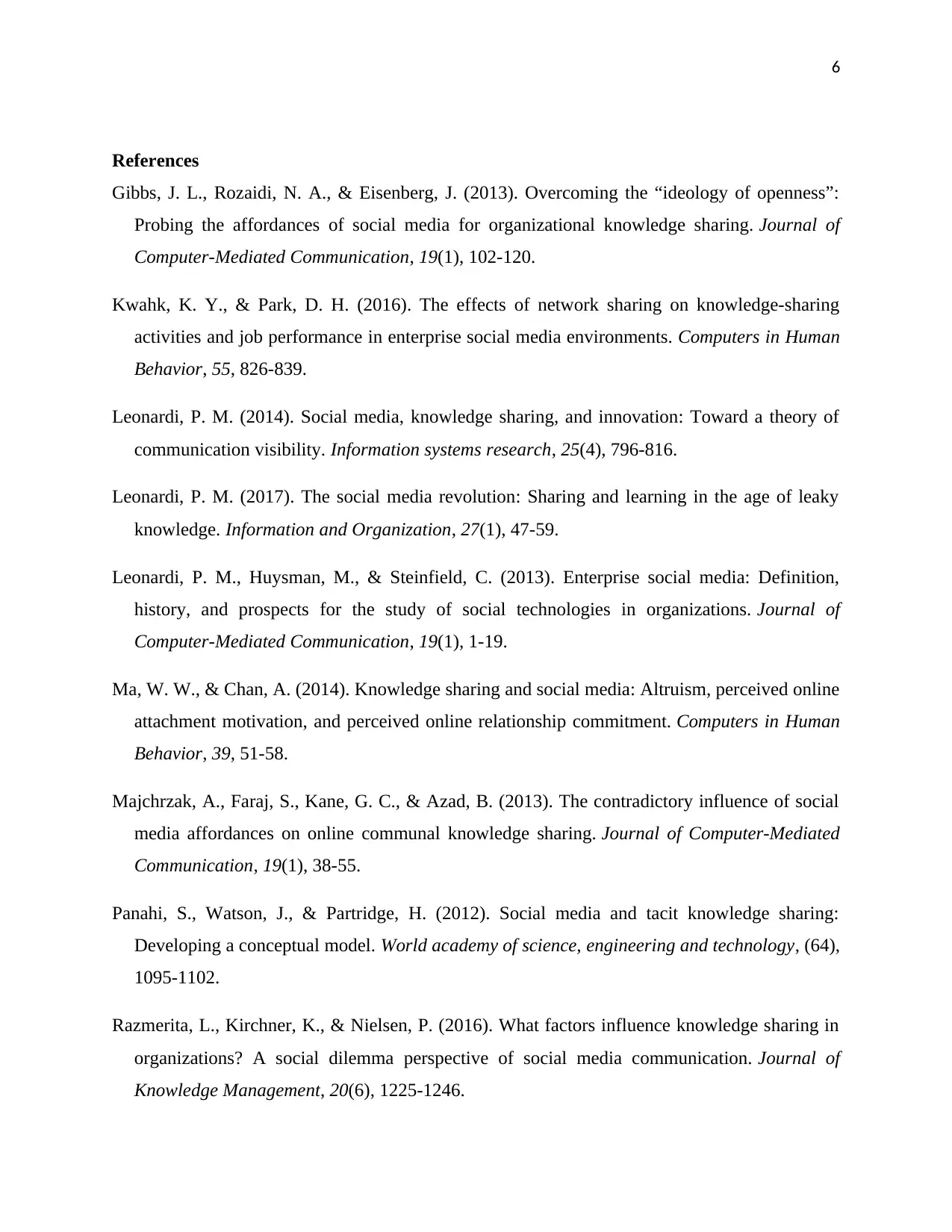
6
References
Gibbs, J. L., Rozaidi, N. A., & Eisenberg, J. (2013). Overcoming the “ideology of openness”:
Probing the affordances of social media for organizational knowledge sharing. Journal of
Computer-Mediated Communication, 19(1), 102-120.
Kwahk, K. Y., & Park, D. H. (2016). The effects of network sharing on knowledge-sharing
activities and job performance in enterprise social media environments. Computers in Human
Behavior, 55, 826-839.
Leonardi, P. M. (2014). Social media, knowledge sharing, and innovation: Toward a theory of
communication visibility. Information systems research, 25(4), 796-816.
Leonardi, P. M. (2017). The social media revolution: Sharing and learning in the age of leaky
knowledge. Information and Organization, 27(1), 47-59.
Leonardi, P. M., Huysman, M., & Steinfield, C. (2013). Enterprise social media: Definition,
history, and prospects for the study of social technologies in organizations. Journal of
Computer-Mediated Communication, 19(1), 1-19.
Ma, W. W., & Chan, A. (2014). Knowledge sharing and social media: Altruism, perceived online
attachment motivation, and perceived online relationship commitment. Computers in Human
Behavior, 39, 51-58.
Majchrzak, A., Faraj, S., Kane, G. C., & Azad, B. (2013). The contradictory influence of social
media affordances on online communal knowledge sharing. Journal of Computer-Mediated
Communication, 19(1), 38-55.
Panahi, S., Watson, J., & Partridge, H. (2012). Social media and tacit knowledge sharing:
Developing a conceptual model. World academy of science, engineering and technology, (64),
1095-1102.
Razmerita, L., Kirchner, K., & Nielsen, P. (2016). What factors influence knowledge sharing in
organizations? A social dilemma perspective of social media communication. Journal of
Knowledge Management, 20(6), 1225-1246.
References
Gibbs, J. L., Rozaidi, N. A., & Eisenberg, J. (2013). Overcoming the “ideology of openness”:
Probing the affordances of social media for organizational knowledge sharing. Journal of
Computer-Mediated Communication, 19(1), 102-120.
Kwahk, K. Y., & Park, D. H. (2016). The effects of network sharing on knowledge-sharing
activities and job performance in enterprise social media environments. Computers in Human
Behavior, 55, 826-839.
Leonardi, P. M. (2014). Social media, knowledge sharing, and innovation: Toward a theory of
communication visibility. Information systems research, 25(4), 796-816.
Leonardi, P. M. (2017). The social media revolution: Sharing and learning in the age of leaky
knowledge. Information and Organization, 27(1), 47-59.
Leonardi, P. M., Huysman, M., & Steinfield, C. (2013). Enterprise social media: Definition,
history, and prospects for the study of social technologies in organizations. Journal of
Computer-Mediated Communication, 19(1), 1-19.
Ma, W. W., & Chan, A. (2014). Knowledge sharing and social media: Altruism, perceived online
attachment motivation, and perceived online relationship commitment. Computers in Human
Behavior, 39, 51-58.
Majchrzak, A., Faraj, S., Kane, G. C., & Azad, B. (2013). The contradictory influence of social
media affordances on online communal knowledge sharing. Journal of Computer-Mediated
Communication, 19(1), 38-55.
Panahi, S., Watson, J., & Partridge, H. (2012). Social media and tacit knowledge sharing:
Developing a conceptual model. World academy of science, engineering and technology, (64),
1095-1102.
Razmerita, L., Kirchner, K., & Nielsen, P. (2016). What factors influence knowledge sharing in
organizations? A social dilemma perspective of social media communication. Journal of
Knowledge Management, 20(6), 1225-1246.
Paraphrase This Document
Need a fresh take? Get an instant paraphrase of this document with our AI Paraphraser
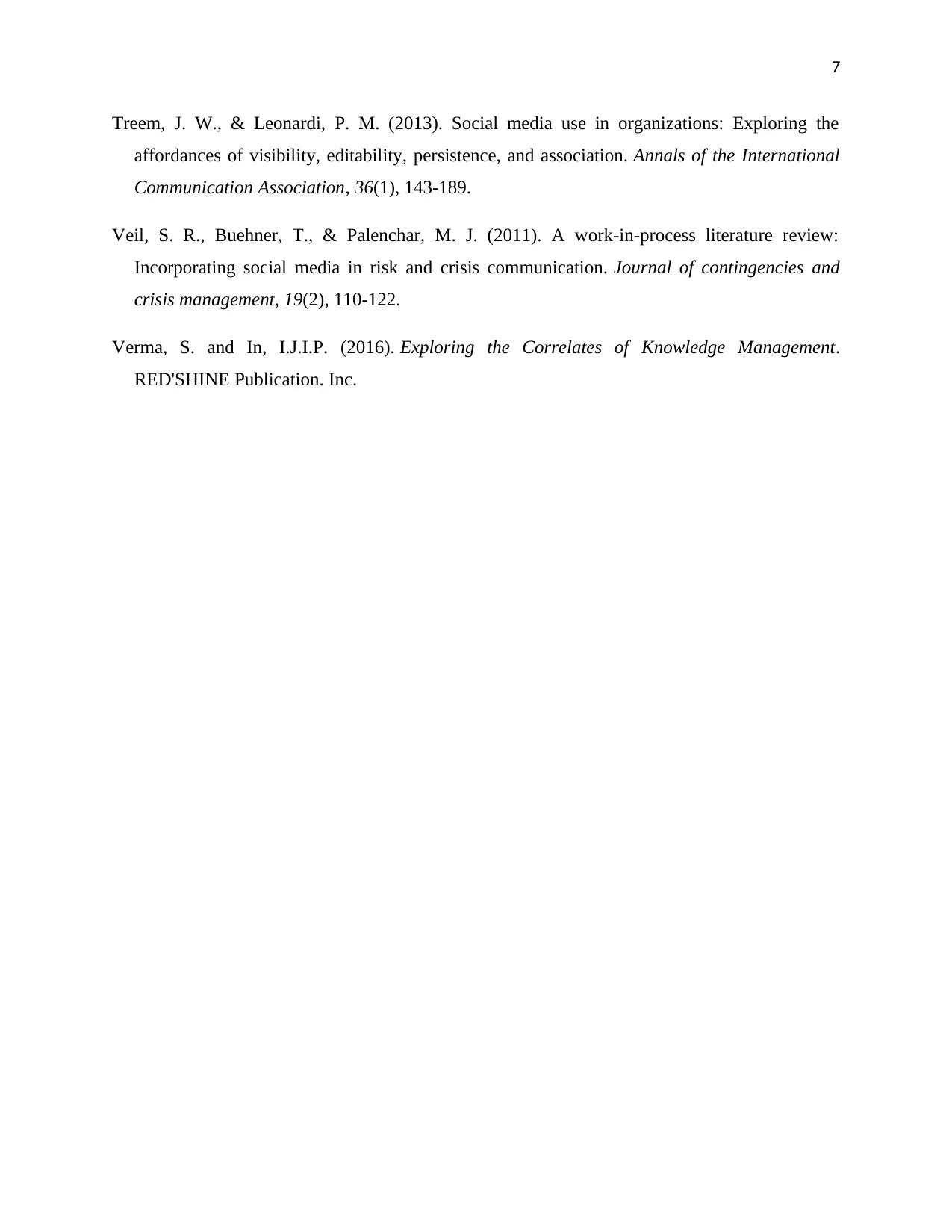
7
Treem, J. W., & Leonardi, P. M. (2013). Social media use in organizations: Exploring the
affordances of visibility, editability, persistence, and association. Annals of the International
Communication Association, 36(1), 143-189.
Veil, S. R., Buehner, T., & Palenchar, M. J. (2011). A work‐in‐process literature review:
Incorporating social media in risk and crisis communication. Journal of contingencies and
crisis management, 19(2), 110-122.
Verma, S. and In, I.J.I.P. (2016). Exploring the Correlates of Knowledge Management.
RED'SHINE Publication. Inc.
Treem, J. W., & Leonardi, P. M. (2013). Social media use in organizations: Exploring the
affordances of visibility, editability, persistence, and association. Annals of the International
Communication Association, 36(1), 143-189.
Veil, S. R., Buehner, T., & Palenchar, M. J. (2011). A work‐in‐process literature review:
Incorporating social media in risk and crisis communication. Journal of contingencies and
crisis management, 19(2), 110-122.
Verma, S. and In, I.J.I.P. (2016). Exploring the Correlates of Knowledge Management.
RED'SHINE Publication. Inc.
1 out of 8
Related Documents
Your All-in-One AI-Powered Toolkit for Academic Success.
+13062052269
info@desklib.com
Available 24*7 on WhatsApp / Email
![[object Object]](/_next/static/media/star-bottom.7253800d.svg)
Unlock your academic potential
Copyright © 2020–2025 A2Z Services. All Rights Reserved. Developed and managed by ZUCOL.





